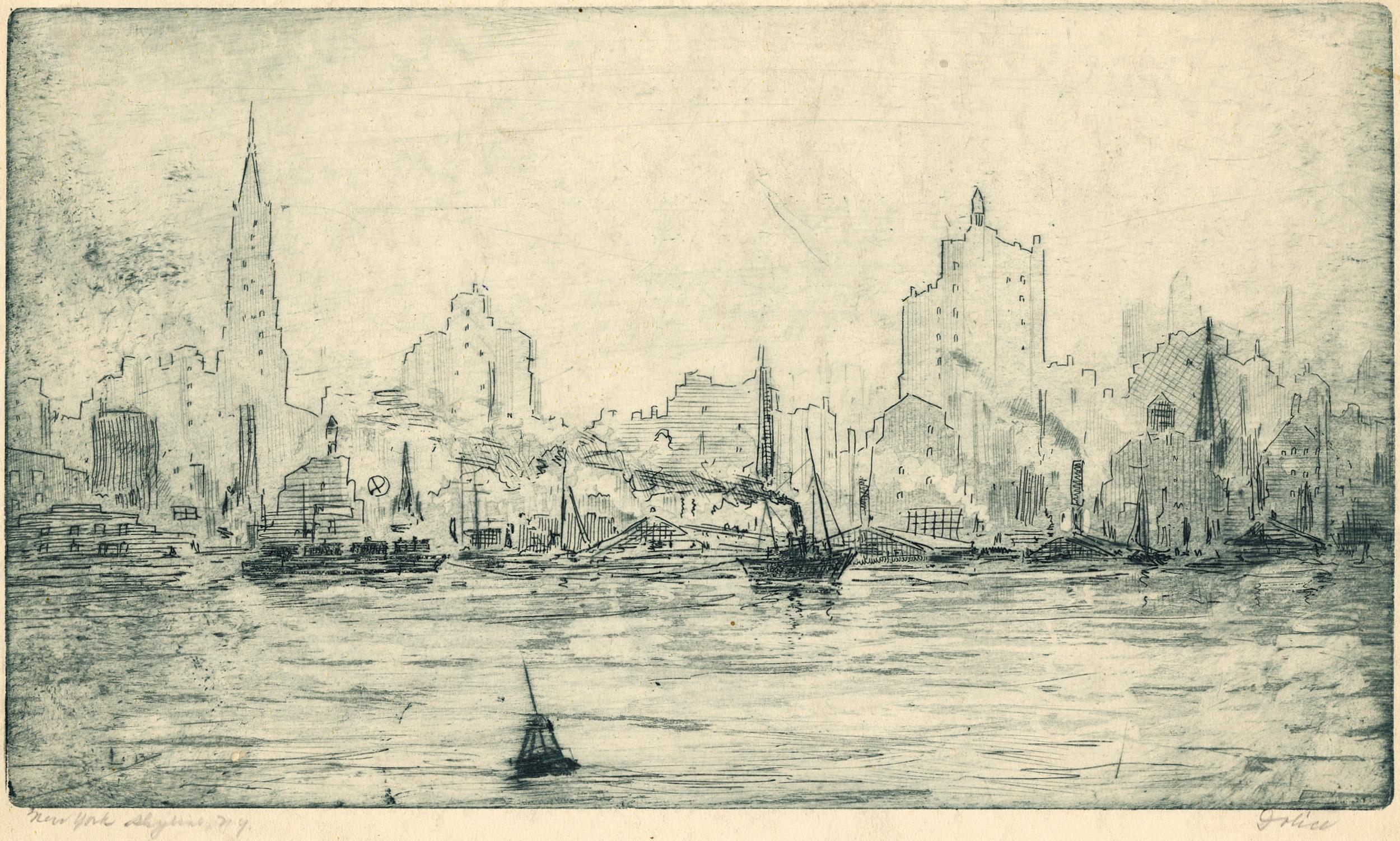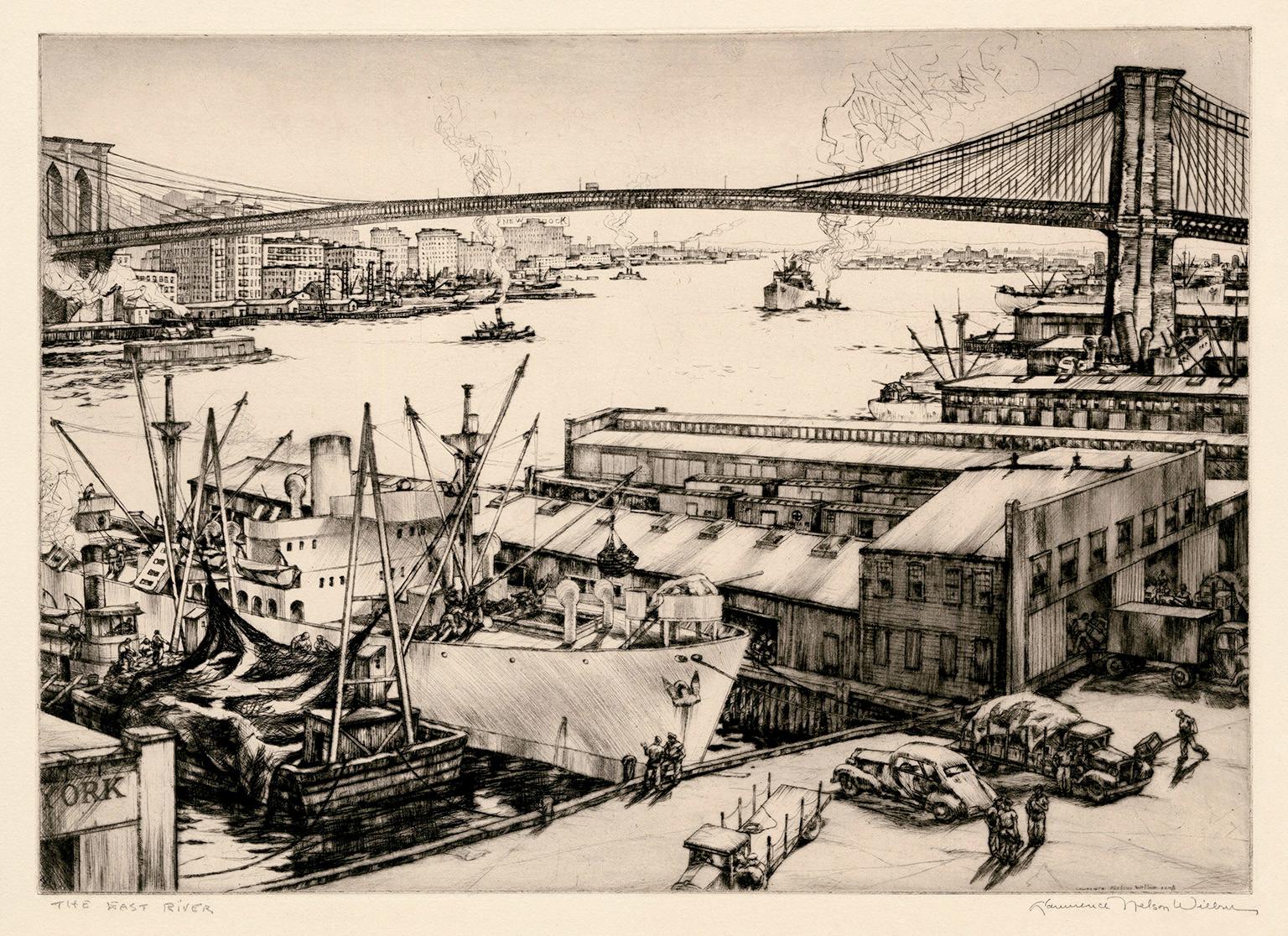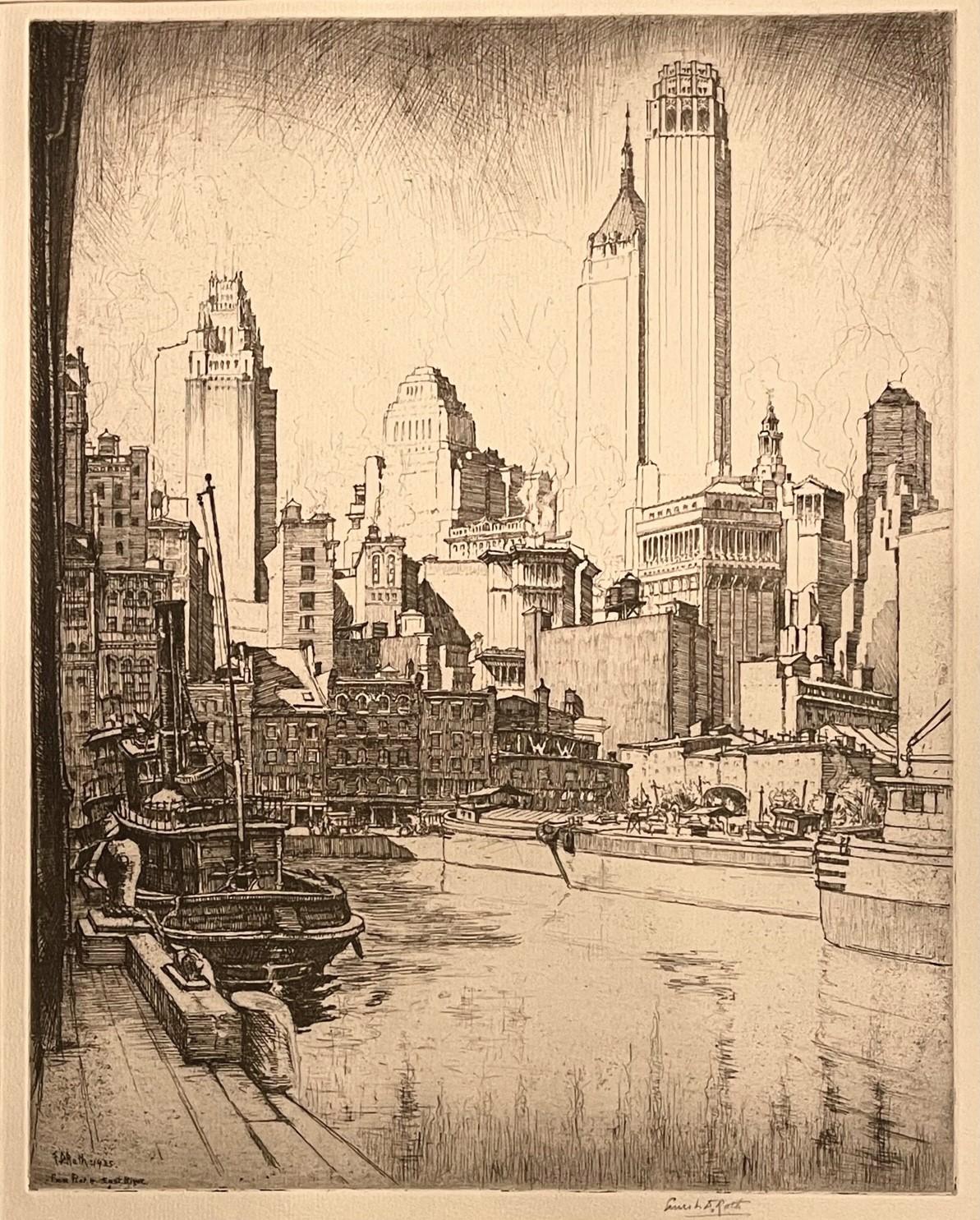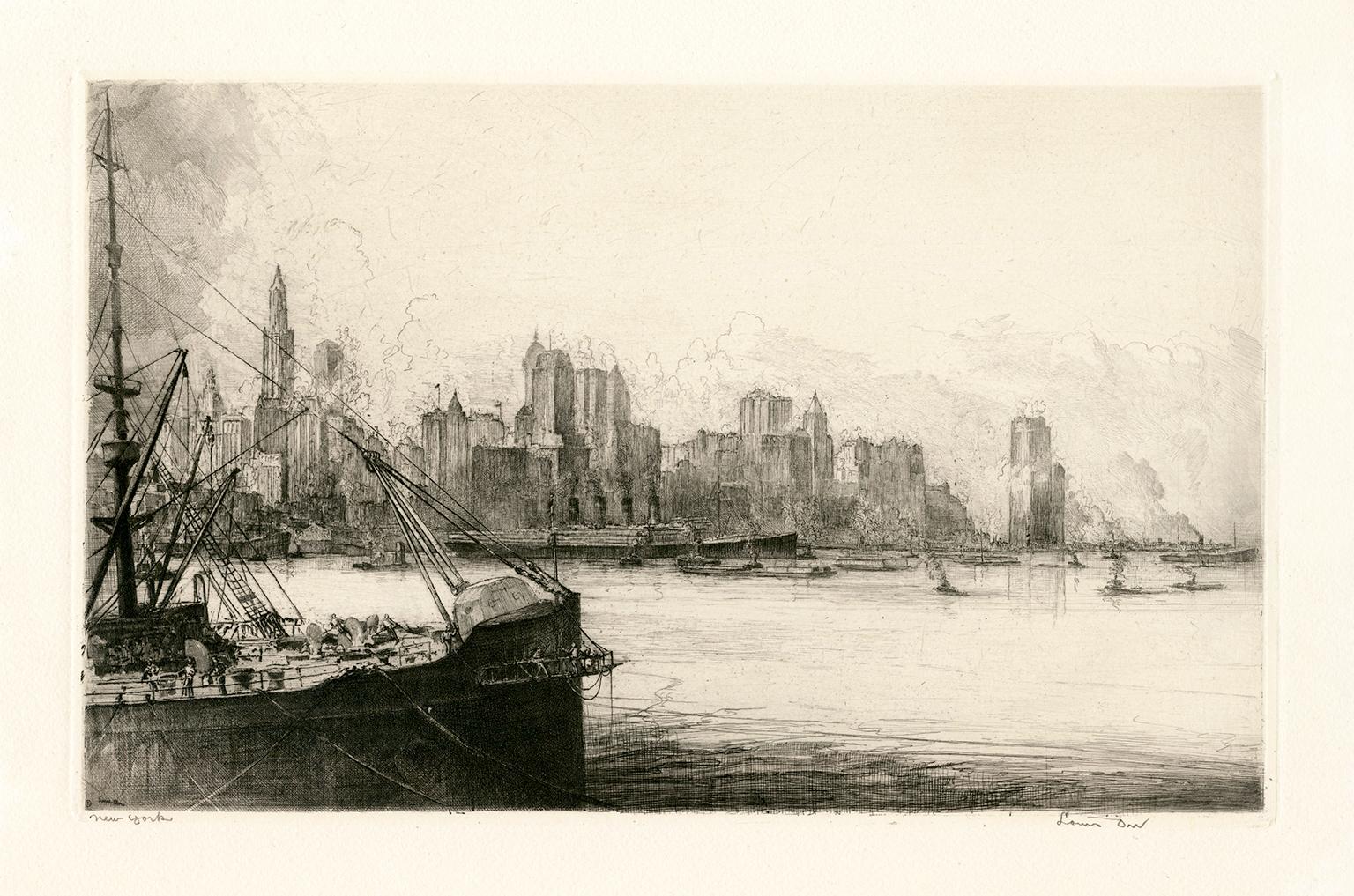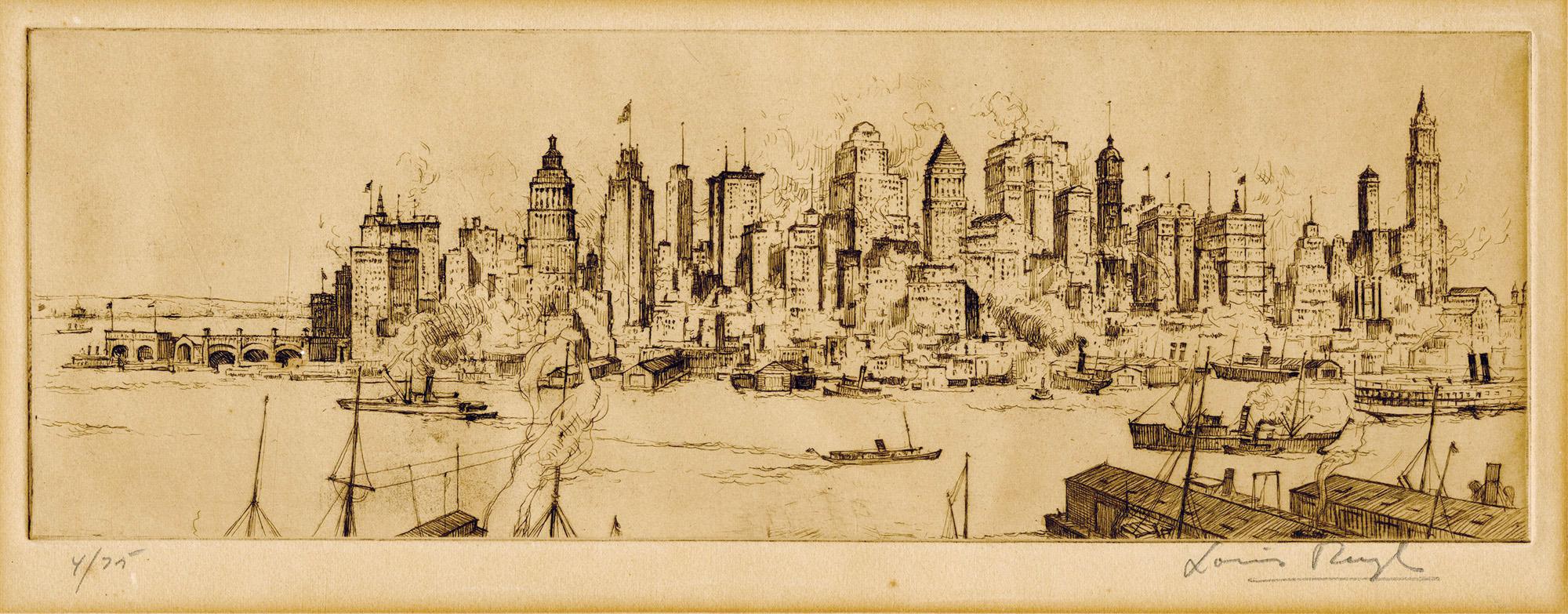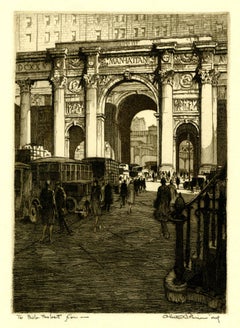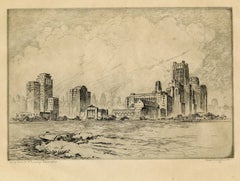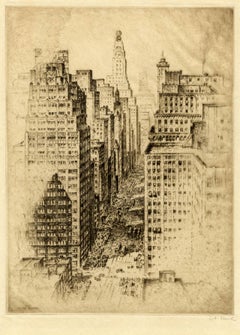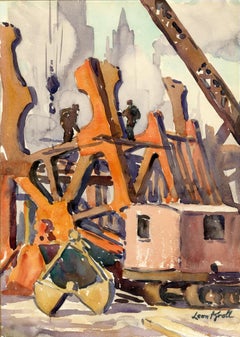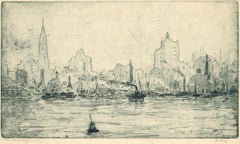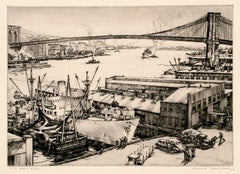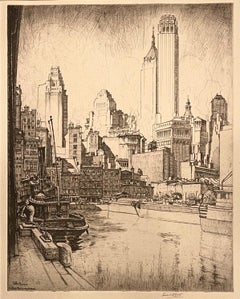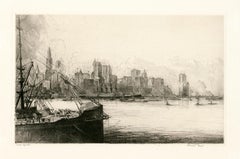Items Similar to East River View of N.Y.
Want more images or videos?
Request additional images or videos from the seller
1 of 8
Mark FreemanEast River View of N.Y.1934
1934
$750
£571.62
€653.40
CA$1,055.20
A$1,155.94
CHF 608.44
MX$13,796.47
NOK 7,756.11
SEK 7,090.25
DKK 4,880.78
About the Item
East River View of N.Y.
Etching, 1934
Signed, dated and titled in pencil by the artist
From a very small edition.
Brilliant impression
Condition: Excellent
Image/Plate size: 5-1/8 x 7-1/8"
Sheet size: 7 5/8 x 10 1/4 inches
"Painter and printmaker Mark Freeman was born in Zaleszczyki, Austria, on September 17, 1908, and he came to the United States in 1923. Freeman first majored in architecture, earning both his BA and MA from Columbia University. There, he became known for his constant sketching, capturing the buildings on campus and the contruction of Riverside Church,George Washington Bridge, and more. At this time he also worked as an editor and graphic artist for the magazines Morningside and Varsity.
Following graduation in 1932, he traveled to Paris, where he earned a Diploma of Art at the Sorbonne. He then returned once more the New York and took additional classes at the National Academy of Design. His early interest in architecture would prove to be a constant source of inspiration and Freeman would become known for his works chronicaling the growth of New York City, as well as the demolition of older structures to make way for new. He wa an early experimentor of the airbrush technique and would sometimes incorporate color onto his printed works using the relatively new medium. This included the futuristic images he contributed to the New York World's Fair, whose theme that year was "The World of Tomorrow." He was a member of the Audubon Artists and a lifetime honorary member of the Lotus Club. Among his noted solo exhibitions were shows at Hirschl & Adler Gallery and the Sylvan Cole Gallery.
In addition to his career as an artist Freeman was a supporter of the arts in his community, and served at various times as president, vice president, or chairman of the American Society of Contemporary Artist (1975 - '77); the New York City Artists Equity Association (1976 - '83); the Artists Welfare Fund 1976 - '83); Board of trustees, Artists Fellowship (1981 - '88); and the Advisory Board, Artists Fellowship (1988 - 2002), among others.
Mark Freeman died in New York City on February 6, 2003.
Selected exhibitions:
Cincinnati Museum of Art (1951, '53, '55); Parrish Art Museum (1964; solo); Insitute of Arts and Letters (1968, 1969); 15 Artists of the Region, Guild Hall, East Hampton, NY; New Print Techniques, Philadelphia Museum of Art, PA; Printmakers of Long Island, Parrish Art Museum; South Fork Artists: from Childe Hassam to Jackson Pollock; Four Printmakers, Guild Hall; 80 American Prints, State Dept. Traveling Exhibition (Europe and North Africa); International Biennials of Color Lithography (various); Detroit Art Institute, MI )1990); Bergen Art Museum, Paramus, NJ (1990); Elliot Art Museum, Stuart, FL (1991).
Awards:
Honorary Life President, Audubon Artists
Honorary Life President, National Society of Painters in Casein and Acrylic
Associate Member, National Academy of Design
Selected collections:
Museum of Modern Art, NY
British Museum, London
Whitney Museum of American Art, NY
Metropolitan Museum of Art, NY
National Academy of Design, NY
Brooklyn Museum, NY
Queens Museum of Art, NY
Museum of the City of New York
Library of Congress, Washington, D.C.
Hengeloose Kunstzaal, the Netherlands
Corcoran Gallery of Art, Washington, D.C.
National Museum of American History (Smithsonian Institution), Washington, D.C.
Butler Institute of American Art, OH
Herbert F. Johnson Museum of Art, Ithaca, NY
Norfolk Art Museum, VA
Elliot Museum, Stuart, FL
Fort Wayne Art Museum, IN
Holyoke Art Museum, MA
Springfield Art Museum, MA
Boston Library, MA
Wolfson Foundation, Miami, FL
Slater Art Museum, CT
Parrish Art Museum, Southampton, NY
Guild Hall, East Hampton, NY
Lotus Club, NY
Wichita Art Museum, KS
St. Vincent's College, PA
New Britain Museum of American Art, CT
Courtesy Annex Galleries
- Creator:Mark Freeman (1908-1975, American)
- Creation Year:1934
- Dimensions:Height: 7.58 in (19.26 cm)Width: 10.25 in (26.04 cm)
- Medium:
- Movement & Style:
- Period:
- Condition:
- Gallery Location:Fairlawn, OH
- Reference Number:Seller: FA29521stDibs: LU14015836342
About the Seller
5.0
Recognized Seller
These prestigious sellers are industry leaders and represent the highest echelon for item quality and design.
Gold Seller
Premium sellers maintaining a 4.3+ rating and 24-hour response times
Established in 1978
1stDibs seller since 2013
835 sales on 1stDibs
Typical response time: <1 hour
Associations
International Fine Print Dealers Association
- ShippingRetrieving quote...Shipping from: Fairlawn, OH
- Return Policy
More From This Seller
View AllThe Manhattan Municipal Building
By Chester B. Price
Located in Fairlawn, OH
Signed in pencil and annotated "imp" lower right; Dedicated lower left: "To Bob Nisbet from…"
Note: Desgined by William M. Kendall of McKim, Mead and White, this classical skyscra...
Category
1910s Landscape Prints
Materials
Drypoint
New University Chicago Campus
By Kent Hagerman
Located in Fairlawn, OH
Signed and titled in pencil by the artist
Category
1920s Landscape Prints
7th Avenue Canyon
By Anton Schutz
Located in Fairlawn, OH
7th Avenue Canyon
Etching, 1927
Signed and titled in pencil by the artist (see photo)
Depicts what was then referred to s the Garment Disctrict in New York City.
References And Exhib...
Category
1920s American Modern Landscape Prints
Materials
Etching
Building New York
By Leon Kroll
Located in Fairlawn, OH
Building New York
Watercolor on paper, c. 1915
Signed by the artist lower right (see photo)
Partial watermark: "MADE IN ENGLAND... LINEN FIBER"
Excellent, COLORS FRESH AND VIBRANT
Br...
Category
1910s American Realist Landscape Drawings and Watercolors
Materials
Watercolor
Western Hills Viaduct Under Construction
By Louis Conrad Rosenberg
Located in Fairlawn, OH
Western Hills Viaduct Under Construction
Drypoint, June 1931
Signed in pencil lower right (see photo)
Initialed and dated in the plate lower right above pencil signature (see photo)
From: Cincinnati Series, 1930-1931, 8 plates, this No. 5
Small edition, not specified
From Greenfield Hill
Condition: Excellent
Image/Plate size: 8 1/2 x 15 1/4 inches
Sheet size: 11 1/4 x 18 1/2 inches
Louis Conrad Rosenberg
1890-1983
An American architectural etcher...
Category
1930s American Modern Landscape Prints
Materials
Drypoint
New Viaduct
By Louis Conrad Rosenberg
Located in Fairlawn, OH
From: The Cleveland Set (23 plates), No. 1
Edition: Small
Signed in pencil
Image: 7 3/4 x 11 1/2"
Category
1920s Landscape Prints
Materials
Drypoint
You May Also Like
New York Skyline, NY; East River
By Leon Dolice
Located in Middletown, NY
Etching on medium stock, cream wove paper, 5 15/16 x 10 3/16 inches (151 x 259 mm), full margins. Signed and titled in pencil, lower margin. A fine and detailed impression in dark bl...
Category
1930s American Modern Landscape Prints
Materials
Archival Paper, Etching
'The East River', Brooklyn Bridge — Mid-Century Realism, New York City
By Lawrence Wilbur
Located in Myrtle Beach, SC
Lawrence Nelson Wilbur (1897-1988), 'The East River', drypoint, edition 65, 1946. Signed, titled, and annotated 'A. Jones Proof 1946' in pencil. Signed and dated in the plate, lower ...
Category
1940s American Modern Landscape Prints
Materials
Drypoint
FROM PIER 4 - EAST RIVER
By Ernest David Roth
Located in Portland, ME
Roth, Ernest (American, 1879-1964). FROM PIER 4 - EAST RIVER. Etching, not dated. Edition size not stated. Signed in Pencil, and titled in pencil at the lower edge, and Signed, dated...
Category
Mid-20th Century Landscape Prints
Materials
Etching
New York (from Ports of America)
By Louis Orr
Located in Myrtle Beach, SC
Louis Orr, 'New York' (from the portfolio 'Ports of America', published by Yale University Press, 1928), etching, 1925, edition not stated. Signed and titled in pencil. Signed in the...
Category
1920s Realist Landscape Prints
Materials
Etching
'New York, View of the East River', Paris, Metropolitan Museum, Smithsonian
By Max Pollak
Located in Santa Cruz, CA
Signed lower right, 'Max Pollak' (American, 1886-1970) with number and limitation, lower center, '21/150' and titled, lower left, 'New York: East River'. Published by Rudolph Lesch a...
Category
1920s Modern Landscape Prints
Materials
Paper, Etching
New York Skyline
By Louis H. Ruyl
Located in Middletown, NY
Etching with drypoint on cream wove paper with deckle edges, 4 3/8 x 12 3/4 inches (233 x 323 mm); sheet 9 1/2 x 15 3/4 inches (240 x 338 mm), full margins. Signed and numbered 4/75 ...
Category
Early 20th Century American Modern Landscape Prints
Materials
Handmade Paper, Etching, Drypoint
